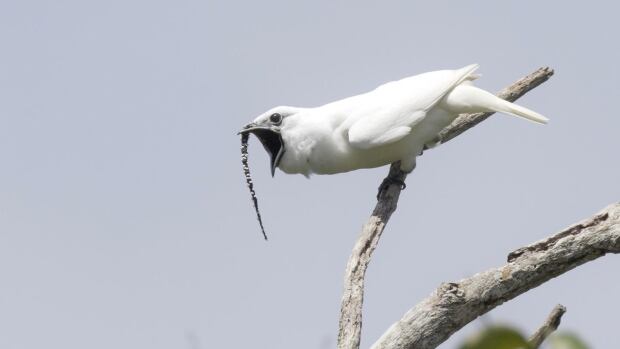This little bird is the loudest in the world

It may be as small as a cooing pigeon, but this bird can belt it out louder than a jackhammer.
New measurements show the white bellbird, a fruit-eating, treetop bird in the northern mountains of the Amazon rainforest, has broken the record for the loudest bird song in the world.
When the male takes a deep breath and “sings,” it sounds a bit like the bird is screaming “hockey,” but with a ringing tone that is its namesake. It’s more than nine decibels louder and has three times the sound pressure compared to the previous record holder, a relative called the screaming piha, researchers report in Current Biology this week.
In fact, its peak volume is higher than that of an eight-lane highway and similar to that of a clanging pile driver, says Jeffrey Podos, a biologist at the University of Massachusetts and lead author of the study.
The arresting call is one of the distinctive features that males use to court females, along with their snow-white plumage and a long, fleshy black, worm-like ornament near their beaks.
In case you’re wondering, the goal isn’t to attract females from far away — the males scream while twirling right in front of them.
“It’s bizarre,” Podos said.
Females are similar in size, but jade green with dark streaks. A male only prepares to sing when the female sidles up next to him and stays there. The male sings its first note with its back to the female, then turns suddenly.
“It’s really dramatic. You see this bird spinning around, and he’s got his beak wide open,” Podos said. “And he blasts the second note right in the place female would have been had she not been smart enough to back off.”
Typically, the females know to fly off to avoid being deafened.
“When you watch them, it looks like they don’t like it,” said Podos. “It’s pretty socially awkward.”
Ripped abs
That makes the purpose of the ritual somewhat puzzling to researchers.
Podos first got curious about the white bellbird after being contacted by Mario Cohn-Haft, curator of birds at the Instituto Nacional de Pesquisas de Amazonia, who sent him some interesting photos.
[embedded content]
Cohn-Haft, co-author of the report, had been collecting specimens for the museum. He had shot a bellbird, and when he opened it up, he was impressed by its hefty, well-defined abdominal muscles — very unusual for a bird.
Bellbirds have a reputation for being loud singers, so he wondered if that’s what the muscles were used for.
Podos decided to find out how loud white bellbirds were compared to other birds, but couldn’t find any reliable data. So he and Cohn-Haft decided to collect some.
White bellbirds are extremely difficult to catch as they live in the treetops in remote areas.
But until recently, it’s been hard to accurately measure the volume of bird calls in the field because calibrated instruments used for measuring other sounds, such as highway traffic, tend to average the volume over too long a time period. How far away the bird is can also affect its apparent volume.
The researchers managed to find a new instrument that can measure the volume over as little as two-hundredths of a second. They also purchased a laser range finder to measure the bird’s distance away from them and account for that.
While the resulting numbers are impressive, Podos acknowledges the difficulty of measuring the loudness of bird calls means many birds haven’t had their calls measured, and there may be a louder bird out there.
“Absolutely. I wouldn’t be surprised and I’m not worried — we’re all just in it to see how nature works,” he said, adding other bellbirds and some larger birds especially, such as cranes, could be louder.
In the meantime, he and Cohn-Haft are scrambling to learn as much as they can about the species in the northern mountains of the Amazon that are threatened by development and wildfires in neighbouring valleys. The number of fires in the Amazon set a record this past summer, many deliberately set by farmers to make room for cattle ranching.
While the researchers were studying the white bellbird, in fact, a farmer set fire to a field below the mountain, and the flames spread partway up the mountain before being extinguished.
“It does that another three or four times,” Podos predicted, “and it’s going to just destroy the habitat where we found these birds.”





